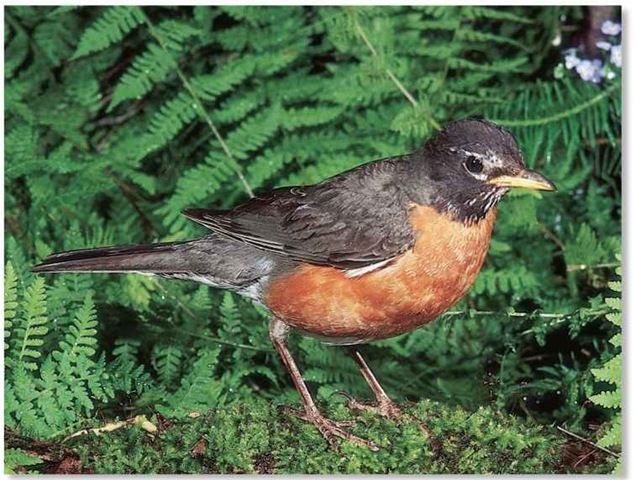ORDER
Passeriformes
FAMILY
Turdidae
GENUS & SPECIES
KEY FEATURES
• Largest North American thrush and one of the most well-known songbirds in the U.S.
• Raises up to 8 young in two broods per year
• its song is a sign that spring is coming; honored as the state bird in connecticut, Michigan and Wisconsin
WHERE IN THE WORLD?
Widespread throughout North America; from Alaska through Canada and the U.S. to southern
Mexico and Guatemala

Lifecycle
The American robin heralds spring with its early arrival from its wintering grounds, and announces daybreak with its persistent, well-known song.
HABITAT
The American robin prefers the deep forest, but it has spread across North America, taking up residence in a variety of habitats. The robin has flourished in areas as varied as sparsely wooded land in the east to mountains 12,000′ above sea level in the western U.S. It has adapted to open regions and modern, suburban areas as well, and is often spotted in pastures, orchards, backyards and city parks. While trees offer the ideal perching site, a suburban fence, gutter or fire escape will work just as well for this adaptable bird. Most robins migrate to the south to escape the harsh, cold winters of the north, but those that stay frequent forests with an abundance of berries.
Natural alarm clock
The American robin’s cheery song signals the start of the day throughout its woodland range.
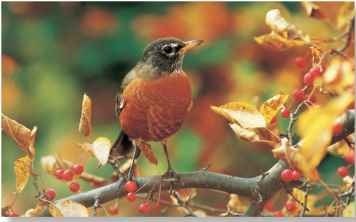
Birds have a higher and more variable temperature than mammals. The robin’s average body temperature is I04°F and may fluctuate over 20°F in 24 hours.
During the long summer days in Alaska, the female American robin will feed her brood for approximately 21 hours each day, so the young grow faster.
FOOD & FEEDING
The American robin changes its diet throughout the year to reap the rewards of seasonally available foods. During the warm spring and summer months, the robin surveys backyard lawns, meadows and even golf courses to search for its favorite food — earthworms. The robin peers carefully across the ground for the worm’s tunnels,then pokes in its beak to search for food.The robin also munches on a variety of insects, from ants and beetles to termites and weevils. Even quick-hopping grasshoppers and fluttering butterflies aren’t safe from the American robin. In the fall, the robin feasts on carbohydrate-rich fruits, which help it fatten up in preparation for a harsh winter or long migration.Those birds that do overwinter in northern regions exist on the berries and seeds that remain uncovered by snow. Pieces of oranges and apples, raisins and bread provide tasty treats at bird feeders. Old apple orchards provide retreats from the cold.
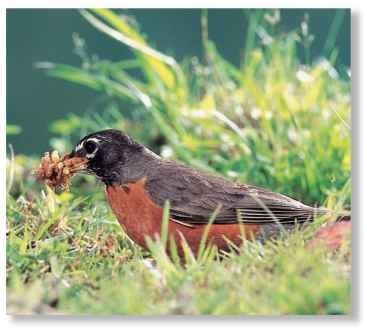
Though the robin arrives early at its nesting grounds, it wastes no time with elaborate courtship displays. Attempting 2-3 broods each season, the male establishes a territory and the female quickly begins a nest after pairing off.For the first brood, the nest is in an evergreen tree.The female forms the mud-lined nest of grasses and rootlets by sitting and pressing her breast against the edges. She lays 4-5 eggs, which are a medium sky-blue color; and incubates them for 14 days. After hatching, the young stay in the nest for about 13 days. The male feeds the fledglings while the female builds a second nest in a maple, elm or other deciduous tree.
TODAY’S DINNER
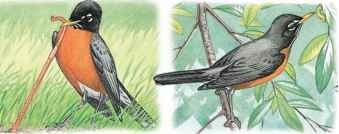
1 Wiggling worms
In spring, a male robin exploits an open, grassy area to play a fatal tug-of-war game with an unlucky earthworm.
2 Creeping caterpillars
In summer, a female American robin plucks a slow-moving caterpillar from a hanging leaf to feed to her hungry chicks.
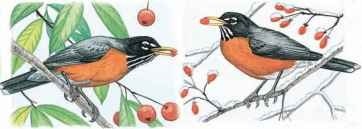
3 Fleshy fruit
A male pecks at a ripe cherry.The sugary fruit helps the robin put on weight for its long migratory journey in the fall.
4 Bittersweet berries
An overwintering robin subsists on berries, such as holly and rowan, during the cold winter.
First meal
The hatchling opens its mouth for food.
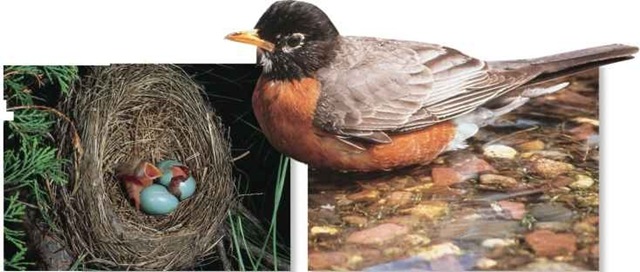
CONSERVATION
The widespread and common American robin is in no danger. But since it frequents suburban areas, including backyards and city parks, toxic weedkillers used on lawns have often resulted in mass poisonings.
BEHAVIOR
The robin starts its trek north in February when the days reach an average temperature of 37°F. Its migratory patterns are not clear-cut; even its scientific name, from the Latin “migrator;” means wanderer. Large flocks of males arrive in northern states in March. As they begin to form territories, they are much less tolerant of the other males. In an “attack run” an aggressive male often bends to a horizontal position with its tail raised and then charges toward another male. A less-aggressive robin may push another male, or take short runs toward it, forcing it to retreat.
When flocks of females show up in April, each mature male has established an individual territory about an acre in size, which becomes smaller in preparation for nesting, about a third of an acre. From high perches, the males serenade the females.The loud, familiar cheerily-cheery-cheerily-cheery sounds serve as a morning wake-up call and evening lullaby. But it also advertises the boundaries of their territory. Often aggressive even outside its territory when foraging, the robin occasionally confronts Wade and bathe its own reflection, in either shallow water satisfies a window or hubcap. drinking and bathing needs.
Profile
American Robin
The American robin is a bird of vibrant colors — from its rich, red breast to its brilliant “robin’s-egg blue” eggs.
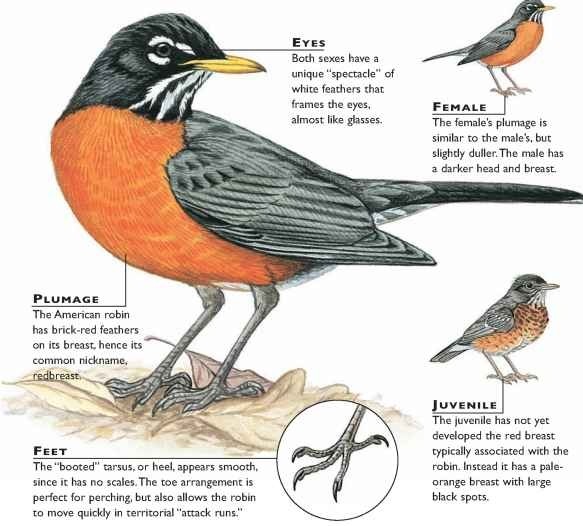
CREATURE COMPARISONS
Though similar in size and color to the American robin, the varied thrush (Ixoreus naevius) has more orange coloring. An orange stripe over its eyes and bright wing bars help distinguish it from its relative.The varied thrush’s range is restricted to the Pacific coast of North America, where it resides in high mountain forests and misty evergreen woodlands. It spends more time in the trees than the robin, feeding mainly on insects and berries. Like the robin, the varied thrush favors earthworms.

| VITAL-STATICS Weight Length |
2.5-3.5 oz. 9-11″ |
| Sexual Maturity | 1 year |
| : Breeding Season | April-August |
| Number of Eggs Incubation f Period |
4-6 12-14 days |
| ; Fledging Period | 2-4 weeks |
| 1 Breeding Interval | 2-3 broods per year |
| ( Typical | Diet | Earthworms, insects, fruits, berries and seeds |
| Lifespan | Up to 12 years in the wild, 17 years in captivity |
RELATED SPECIES
• The genus Turdus, which includes the American robin, is one of over 50 genera in the family Turdidae. This family includes over 300 species of thrushes.The eastern bluebird, Sialia sialis, is a common North American species. Despite its name, the European robin, Erithacus rubecula, is closer in color patterns and behavior to the eastern bluebird than to the American robin.
